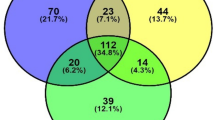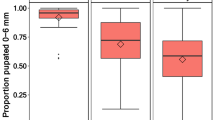Abstract
SPECIMENS of dead soil-inhabiting insect larvae (Anomala sp. and Heteroligus sp.) and noctuid larvae were supplied to me or collected by me for microbial isolations. Larvae of Anomala and noctuids were collected from fields on Moor Plantation, Ibadan, while yam-beetle larvae (Heteroligus sp.) were collected around Benin and Onitsha. Anomala and Heteroligus lavae were either dead on being dug up in the field or died while under storage in moist soil in the laboratory. Stored larvae were adequately provided with food (for example, pieces of yam) and aeration.
This is a preview of subscription content, access via your institution
Access options
Subscribe to this journal
Receive 51 print issues and online access
$199.00 per year
only $3.90 per issue
Buy this article
- Purchase on Springer Link
- Instant access to full article PDF
Prices may be subject to local taxes which are calculated during checkout
Similar content being viewed by others
References
Steinhaus, E. A., Principles of Insect Pathology (McGraw-Hill Book Co. Inc., New York, 1949).
Okafor, M. N., Ph.D. thesis, Univ. Cambridge (1964).
Wigglesworth, V. B., Biol. Rev., 23, 408 (1948).
Gray, T. R. G., and Bell, T. F., in Soil Organisms, edit. by Doeksen, J., and van der Drift, J. (Amsterdam, 1963).
Author information
Authors and Affiliations
Rights and permissions
About this article
Cite this article
OKAFOR, N. Micro-organisms associated with Dead Insect Larvae in Nigeria. Nature 208, 1015–1016 (1965). https://doi.org/10.1038/2081015a0
Issue Date:
DOI: https://doi.org/10.1038/2081015a0
This article is cited by
-
Fermentation research in Nigeria
MIRCEN Journal of Applied Microbiology and Biotechnology (1988)
-
The microbial breakdown of linamarin in fermenting pulp of cassava (Manihot esculenta Crantz)
MIRCEN Journal of Applied Microbiology and Biotechnology (1986)
-
Thermophilic Micro-organisms from Rotting Maize
Nature (1966)
Comments
By submitting a comment you agree to abide by our Terms and Community Guidelines. If you find something abusive or that does not comply with our terms or guidelines please flag it as inappropriate.



